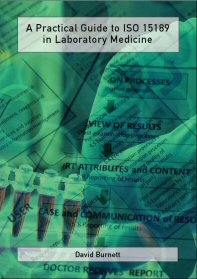Guest Essay
Dr David Burnett's new book on ISO 15189
With every new version of ISO 15189, there's a need to update the laboratory approach to obtaining accreditation. Just in time, Dr. David Burnett has updated his textbook: A Practical Guide to ISO 15189 in Laboratory Medicine.
A Practical Guide to ISO 15189 in Laboratory Medicine.
 October 2013
October 2013
Daivd Burnett
380 Pages
ISBN 978-0-902429-49-9
Available from the Association of Clinical Biochemistry and Laboratory Medicine (UK) (http://www.acbstore.org.uk) or in the USA from the American Association of Clinical Chemistry (http://directaacc.org).
Words from the author and a short synopsis
This book is primarily intended as a practical guide for laboratory professionals wishing to implement the International Standard, ISO 15189:2012 Medical laboratories – Requirements for quality and competence, in their laboratories, but will also be useful to peer review assessors or full time assessors working for accreditation bodies. It may seem presumptuous to have created for the purpose of this book an outline structure of an ‘Ideal Standard’ for use in the accreditation of medical laboratories, but it is essential to the structure and interactivity of the contents of the book which are presented in ten chapters and three appendices:
- 1. ISO 15189 – The standard for the medical laboratory
- 2. Defining and managing quality in the medical laboratory
- 3. Organisation and management responsibility
- 4. Quality management system
- 5. Personnel
- 6. Accommodation and environmental conditions, including occupational health and safety
- 7. Laboratory equipment, reagents, consumable (IVD) and external services
- 8. Pre-examination and post-examination processes
- 9. Examination processes and ensuring the quality of examination results
- 10. Evaluation and continual improvement
- Appendix A The ‘Ideal Standard’ and ISO 15189:2012
- Appendix B St Elsewhere’s Quality Manual
- Appendix C Bibliography
Where appropriate, examples of possible approaches are presented from the Pathology Laboratory of St Elsewhere’s Regional Hospital Trust. These examples are not necessarily the perfect solution to everybody’s real life problems but are intended to stimulate thought as to the appropriate way forward. In common with many laboratories seeking accreditation, the laboratory at St Elsewhere’s used to ask, ‘Does this activity meet the requirements of ISO 15189?’, but now every time the laboratory undertakes a particular activity it asks ‘How does this activity ensure the quality of the service provided to the user?’. This change in approach causes each member of staff to think carefully about the rationale behind each ISO 15189 requirement before implementing it.
I have had the good fortune to work with colleagues from many countries on groups concerned with accreditation and the preparation of the 3rd Edition of ISO 15189. This book, is a thank you for that experience and friendship and my hope is that it will make the task lighter for those just beginning to implement ISO 15189 in their laboratories and be an aid to continual improvement for those who are old hands at the job.
